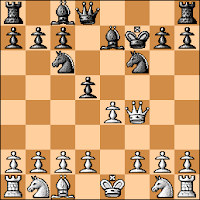
RevvedUp challenges Shredder 8 with its own defensive idea; yet, in the end, the silicon beast outplays him. This game is less about Jerome Gambit (1.e4 e5 2.Nf3 Nc6 3.Bc4 Bc5 4.Bxf7+) theory and more about how a stronger opponent gives "Jerome Gambit odds" and then gradually outplays his opposition.
Shredder 8 - RevvedUp
2 12, 2006
 Familiar ground.
Familiar ground.7.Qd5+ Kf8 8.Qxc5+ d6 9.Qe3 Qh4
 RevvedUp tries out Shredder 8's innovation (see "Jerome Gambit: Drilling Down (17)").
RevvedUp tries out Shredder 8's innovation (see "Jerome Gambit: Drilling Down (17)").10.Nc3 c6 11.d3 Nf6 12.Qd4
 A real computer-style move: Shredder 8 sees that his opponent's formation leaves the d-pawn unprotected. In this position RevvedUp likely would have chosen 12.Qg5 to exchange Queens.
A real computer-style move: Shredder 8 sees that his opponent's formation leaves the d-pawn unprotected. In this position RevvedUp likely would have chosen 12.Qg5 to exchange Queens.12...Ke7 13.h3 Qh5 14.0-0 Qc5
 Again, RevvedUp would like to head toward the endgame. For this 14...Qe5 was also a possibility. Shredder 8 should now swap Queens.
Again, RevvedUp would like to head toward the endgame. For this 14...Qe5 was also a possibility. Shredder 8 should now swap Queens.15.Qa4 Re8
This is a solid move. Black would have gotten his wish after 15...b5 16.Qa5 Qb6 17.Qxb6 axb6 which is probably the stronger line.
16.Be3 Qe5
 Provoking the pawns.
Provoking the pawns.17.f4 Qe6
Better: 17...Qh5
18.f5 Qf7 19.fxg6 Qxg6
 RevvedUp has returned the piece, a standard strategy for Black, but White's position is too strong.
RevvedUp has returned the piece, a standard strategy for Black, but White's position is too strong.20.Rf3 h6 21.Raf1 Be6 22.Qb4 b6 23.e5 Nd5 24.Qxd6 checkmate
 Ouch!
Ouch!























